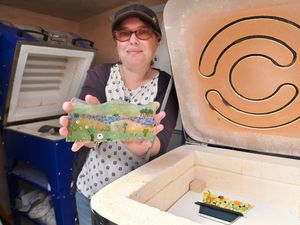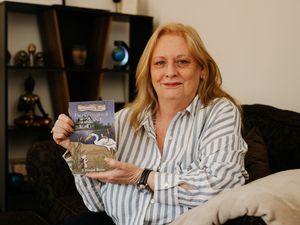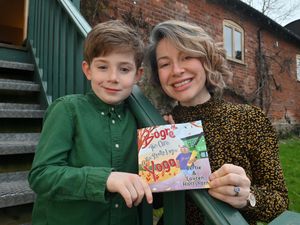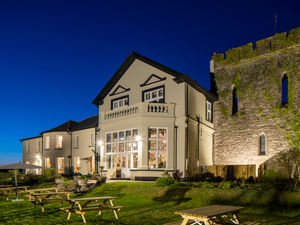Film Talk: Alexander Skarsgard dives into the mud for Viking epic The Northman
There were moments when Alexander Skarsgard was standing in the driving rain and howling wind, covered in mud, that he really called into question the reasons why he had wanted to make a Viking movie.
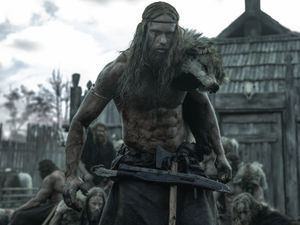
“I asked myself that question every day on set. Why did I want to do this?” he admits with a rueful smile.
But 45-year-old Skarsgard, the Swedish actor who made his name on vampire series True Blood and since carved out a career in films such as The Diary Of A Teenage Girl, The Legend Of Tarzan and Godzilla Vs Kong, and shows such as Big Little Lies, The Little Drummer Girl and Succession, had passionately wanted to tell a Viking story on the big screen.
That dream becomes a reality with The Northman, an action epic based on the ancient Norse saga of a young Viking prince named Amleth – who embarks on a quest to kill his uncle, rescue his mother and avenge his father’s murder.
“I had never seen a great big, epic Viking adventure film that was told in a historically accurate way, that would go deep into the Norse mythology in a serious manner – that’s really why I wanted to make it,” Skarsgard says.
“I was working for a couple of years on a couple of different ideas, trying to figure out which of the Icelandic stories to base it on, or if we should come up with something original, something completely different.”
But then Skarsgard had lunch with the US filmmaker Robert Eggers, the director of acclaimed and disturbing movies The Witch, starring Anya Taylor-Joy, and The Lighthouse, starring Robert Pattinson and Willem Dafoe.
“We were supposed to talk about something else,” Skarsgard recalls, “but he had just come back from Iceland, with no intention of making a Viking movie.
“But he had fallen in love with the island and the culture and Norse mythology, so we started talking about Scandinavia, Viking culture, and we ended up talking about that for two hours. After that, it just felt like fate brought us together. We were meant to do this.”
But Eggers, 38, who had never made a movie on this scale before, had some serious reservations about making a Viking film, and in fact was deeply concerned by many of the associations that come with them.
“I was initially not interested in Vikings. The macho stereotype and the right-wing misappropriation of Viking culture made me not excited about them,” the director says.
“But I took a trip to Iceland and the landscapes were so incredibly powerful and inspiring that they made me want to pick up Icelandic sagas, and I started to get interested in Viking culture through that.
“Then I had lunch with Alexander Skarsgard, and from there I discovered this Nordic myth of Amleth, which inspired Shakespeare’s Hamlet, and I thought, ‘This is the story everybody knows, everyone can relate to, and I can make a large movie for a big audience while still indulging and exploring Viking culture and mythology’.”
Eggers was particularly anxious not to glorify or celebrate the violence that is often associated with Viking culture, in particular sexual violence.
“You really have to consider every choice you’re making very carefully,” he says. “I only allude to sexual violence, I don’t show it. As far as the other physical violence goes, it’s tricky, because it is a culture that celebrates the violence.
“The sagas often read like action movies from the Eighties in their fight scenes. This is a big popcorn movie, it’s a tent-pole action movie, so there are times when the violence does need to be entertaining and thrilling, but I also don’t want to be glorifying violence, I don’t want to be celebrating violence.”
The shoot, which took place outside in the unforgiving climate of Ireland and Northern Ireland, was a gruelling experience, especially for Skarsgard, who transformed his body for the role and spends much of the film either soaking wet, covered in mud, or both.
“It was brutal, but I think it had to be,” the actor says. “It’s a Robert Eggers film, and it’s a Viking movie, so of course we had to be in the mud, we had to shoot it out there on a mountaintop, and not on a soundstage, and I actually think it helped.
“It was helpful as an actor to be out there in the elements on a real set, that was built a year prior to shooting in order for it to grow in and age properly, and done in a way that was historically accurate. It was tremendously helpful.
“So, it was about diving in and existing on that mountaintop, with the wind and the rain and everything, and not trying to fight it, but just embrace it and enjoy it.
“Hopefully the audience will feel that we’re actually out there and it feels more immersive.”

